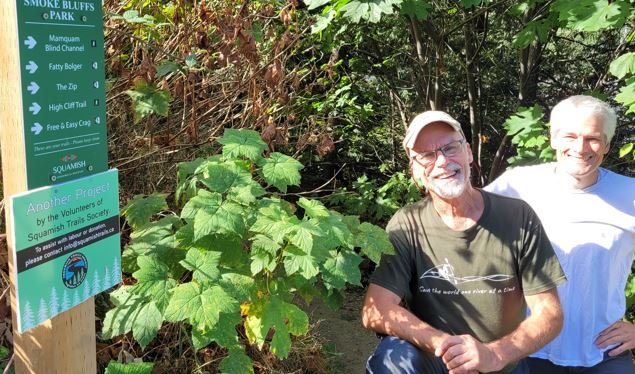
A volunteer-build connector trail in the Smoke Bluffs parks is giving hikers and climbers a better access to the Mamquam Blind Channel.
The Mamquam Blind Channel connector trail, a 400-metre pathway, is just a few steps from the kiosk at the entrance of the Smoke Bluffs Park. It provides an easy connection to the blind channel as it connects to the now defunct access road to the hospital.
The trails society gave $6,000 for the project and it was built by volunteers. Spearheading the effort to create this new connector trail to the blind channel is John Harvey, more widely known as the president of Mamquam River Access Society. But as a private contractor with the District, he also works as the Smoke Bluffs Park caretaker.
The work on connector trail started at the end of 2020 and was completed in March 2021. This year, as expected, the connector trail has proved to be immensely popular with both hikers and climbers as it provides an easy access the blind channel and the climbing routes that dot the area.
Harvey says he knew the area close to the blind channel would only grow in popularity when the District bought the Drenka lands in 2019.
John Harvey got working along with volunteers including Zach Harvey, Kai Friele, Pierre Friele, Ryan McNutt, Bob Feist, Amanda Newman and Ethan Beaudette to clear the area, and creating stairs and boardwalks.
Squamish Trails Society member Heather Sidsworth donated a whole pile of 2×6 for decking, and Neil Dyer from Brackendale donated Black Locust wood, which is extremely rot-resistant and harder and stronger than oak. The group also used material donated by Van Urban and they used a fallen fir tree, cutting into beams and creating boardwalk support.
“It was good old grunt work,” says Harvey, smiling. “And people started using this instantly, and it has been very popular this summer,” he says.
Harvey is also appreciative of the District for supporting the project. “I want to stress that I fully appreciate the District recognizing the importance of the Smoke Bluffs as an ‘internationally famous’ rock-climbing destination deserving of special attention. The purchase of the Drenka lands shows the importance the District places upon this municipal park.”
Matt Parker, the president of Squamish Trails Society, said the connector creates a nice loop for people to enjoy.
“This has been great for hikers because now you can come down to the park and loop back to the park. It creates a self-contained loop and people typically like to hike in loops in park-like settings,” Parker says.
Both the Squamish Trails Society and Harvey are now brainstorming on which trails in the Smoke Bluffs could be upgraded for better experience for both hikers and climbers.







Patricia Marini says
Beautiful! Thanks
Nadine says
For humans wanting to hike along the water front of the Upper Blind Chanel this is a lovely trail. It is however just another lovely trail for humans to walk on the Upper Blind Chanel as the Rose Park trail has been there for many years already allowing access to walk along the water front.
Since the purchase of the Drenka Lands the humans have been very busy cutting down trees, removing vegetation, and placing human amenities such as benches right along the water front. It has attracted more humans as it is now more comfortable for them.
If you follow the water front of the Mamquam Blind Chanel from Howe Sound you will realize that the only section of it that isn’t hardened water front specifically developed for human use is along the shore line of the First Nations Lands and the East Side of the Upper Blind Chanel north of the Red Bridge Development Property.
As is suggested in this article that means there is under half a kilometre of water front on the entire Mamquam Blind Chanel that isn’t just for people yet.
Do we need another trail along the water front and if we do why? Should that trail allow for any use like bikes and horses, and hikers? Is this trail going to be a thoroughfare for humans going somewhere else, or will it be a destination for specific activities?
Or bigger questions, should the east side of the Upper Blind Chanel be more unique than just another trail. Is it possible that we humans could see this four hundred metres as a future piece of a long over due wildlife corridor that is seriously lacking in this community and lacking in any present planning process.
We feel good about providing access to spaces for humans I wonder how we feel about diminishing access to spaces for everything else.